Streamer Fishing For Salmon: Best Tactics and Best Flies
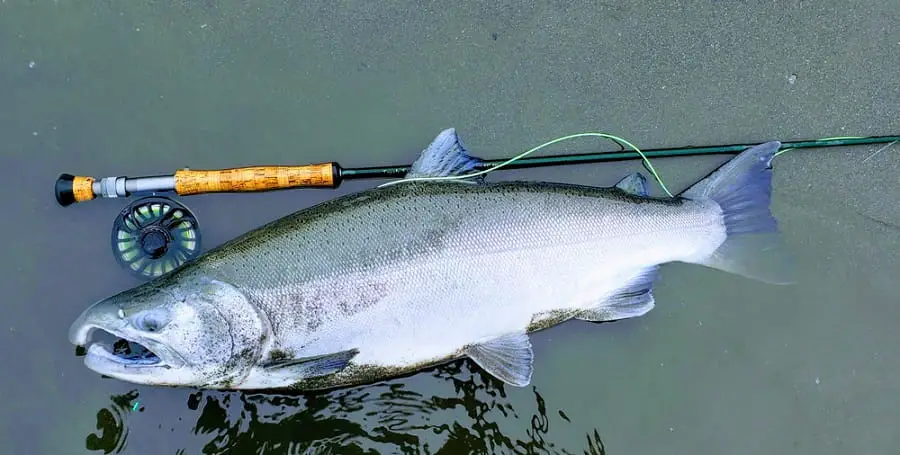
There are times when salmon that have entered the river refuse to eat because they are focused on spawning and not eating. However, streamer fishing for salmon can often be the only way to get them to bite when other flies don’t work.
Streamer flies play on the salmon’s aggression and instinct to bite anything that’s in their territory, even if they’re not hungry. They bite out of aggression when in the rivers they but also bite out of habit to grab anything baitfish-like.
I have a couple of effective streamer fishing tactics that have helped me catch more salmon, which I will discuss in this article.
There are also a number of streamer flies that I use to ensure my clients catch these big, aggressive salmon once they enter the river.
Streamer Fishing For King Salmon
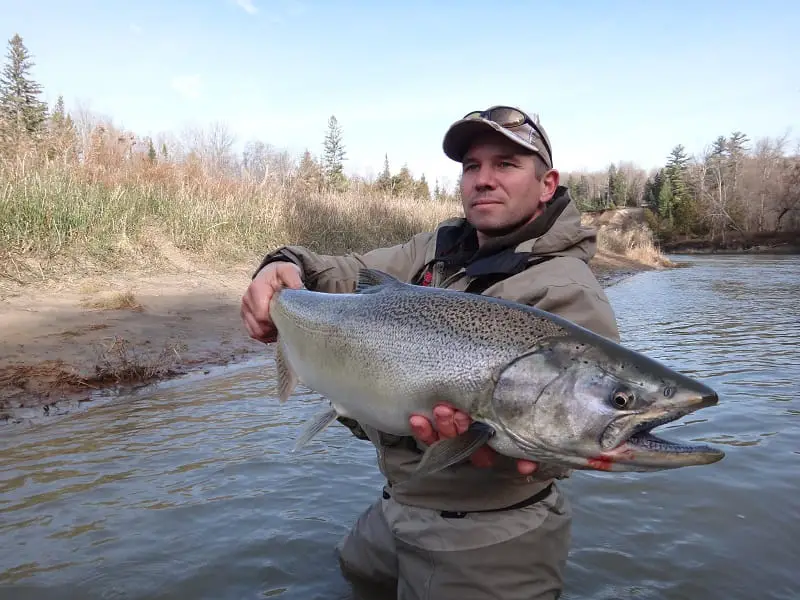
Big king salmon are my favorite salmon species to target with streamers. Once they enter the river, they become sexually even more aggressive, and once on the spawning grounds, they become territorial.
Stripping or swinging flies in front of them can trigger explosive hits.
I prefer 4 to 6-inch streamer flies in bright colors like chartreuse, pinks, oranges, and white.
Fly Rod and Reel For King Salmon: I prefer a nine or ten-weight fly rod in the 9-foot length for salmon fishing with a streamer fly, matched with a suitable fly reel and a floating line with a heavy sink tip. I will use a full sinking line in some situations.
Fly Leader For King Salmon: A 6 to 9-foot leader salmon leader that is 16 to 20 pounds combined with a 12 to 24 inch 14 to 16-pound tippet.
NOTE: When fishing Great Lakes salmon, I tend to be on the lighter end of those leader recommendations, and when fishing West Coast salmon, I will use the stronger leaders.
Streamer Fishing For Coho Salmon
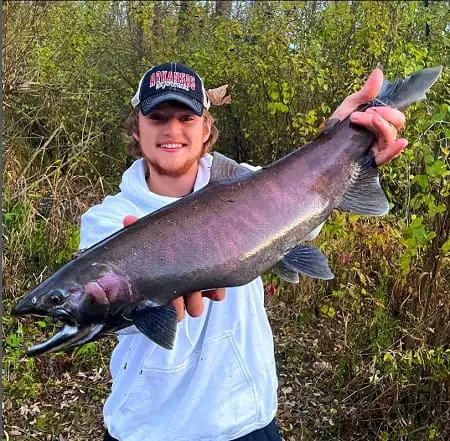
Coho Salmon are another aggressive salmon species I love to fish for with streamers.
Coho fresh in from the ocean will eat as they move up the river, and they are very aggressive on large 4 to 6-inch streamer flies.
My favorite streamer fly colors are red, white, and orange. However, at times, black can be excellent.
I also like to add some flash to my salmon flies, which I think makes a big difference.
Fly Line For Coho Salmon: In shallower water of 6 feet or less, I prefer a floating line with a heavy sink tip. I will use a full sinking line when fishing faster deeper rivers.
Leaders and Tippet For Coho Salmon: A six to 9-foot leader salmon leader that is 16 to 20 pounds combined with a 12 to 24 inch 12 to 14-pound tippet.
NOTE: When fishing Great Lakes salmon, I tend to be on the lighter end of those leader recommendations, and when fishing West Coast salmon, I will use the stronger leaders.
Chum And Pink Salmon Fishing With Streamers
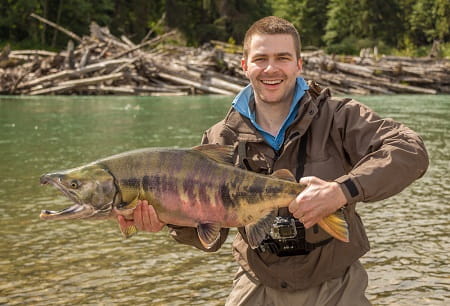
When streamer fishing for Chum salmon, I don’t change my tactics much from how I streamer fish for Coho.
I will use the same streamer flies, gear, and tactics that I use for coho salmon.
Since pink salmon are smaller, I will use lighter fly rods and reels in six to seven-weight with a nine-foot length, tippets around eight to ten pounds, and slightly smaller flies in the 3 to four-inch sizes. Other than that, I do not change my presentation or tactics.
Gear For Streamer Fishing
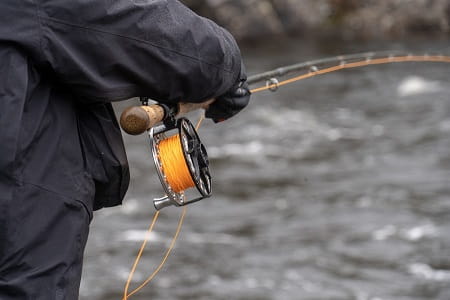
Proper gear helps with casting, hooking, and landing big salmon. The right fly line will improve mending and make stripping and the presentation easier and less effort.
I use the same gear when fly fishing for salmon with nymphs that I do when casting streamers. On another page, I discuss all the best methods for fly fishing for salmon.
The gear I use to catch salmon with a streamer is:
- Waders: Good chest waders will help me get into position and help me access the best water.
- Fly Rod For Salmon: A seven to ten-weight fly rod in medium to fast action in the 9-foot length is best for casting streamers on most rivers. For big west coast king salmon, go with heavier fly rods.
- Fly Reels: It is important to match the fly reel to the rod and have a reel large enough to hold the fly line and at least 200 feet of 30-pound fly line backing.
- Leaders: I use Rio Steelhead and Salmon Leader since they are strong enough and go up to 20 pounds.
- Tippet: A good fluorocarbon tippet is necessary for big, strong salmon and fishing on rocky rivers.
- Streamer Flies: Have a good assortment of streamer flies in the 3 to 6-inch sizes. (see below for my favorite salmon streamer flies)
Aside from these essentials, there is a lot of river fishing gear that I use and recommend. Things such as Nippers, Forceps, Fishing packs, and more.
Favorite Streamers For Salmon Fishing
When it comes to streamers for all species of salmon, many guys make it difficult with many different patterns, sizes, and colors. However, In my experience, the salmon are not that picky, so a few good streamer patterns are all I really need.
What makes a good streamer fly for salmon is size, color, and action. As long as my fly has this, I will do well.
- Streamer Size: I use streamer flies in the 3 to 6-inch size, with four and 5-inch being my go-to sizes. I will drop to smaller sizes in very clear water with nervous salmon. Otherwise, bigger is usually better, especially in big water.
- Streamer Color: The color that works best will really depend on the salmon’s aggressiveness, water clarity, and light conditions. Aggressive salmon will smash bright streamers. Non-aggressive salmon might want black or olive streamers. I have an assortment of white, chartreuse, orange, red, pink, black, and olive. As well as color combinations such as white and pink, orange and pink, blue and black, purple and pink, etc. Adding tinsel and flash to my streamers can make them twice as effective.
- Streamer Action: When salmon fishing, the best streamer flies have materials like marabou, ostrich herl, rubber legs, tinsel, and rabbit fur, all of which will pulsate and provide an almost life-like action that triggers bites. I see a lot of flies tied with these materials and combinations of them.
I mentioned that I don’t really need to go crazy on fly patterns.
There are so many stream fly patterns that anglers will swear by, but most are just variations of other patterns. If I took five different bunny leech variations and presented them all to the salmon, the salmon would probably eat them all.
It’s really hard to say if a salmon I just caught on one fly wouldn’t have also eaten other flies from my box.
The key is plenty of action and plenty of flash or movement that gets their attention. Even a simple wolly bugger or egg-sucking leach works for me all the time.
Try these Salmon Flies
- Steelhead Bunny Leech: Giant Bunny leeches or similar patterns are great for salmon. I use these for stripping and for swinging.
- Better Woolly Gugger (oversized and very bushy) This is a great fly when tied large. I use this stripped or for swinging.
- Circus Peanut: It’s a trout fly, but when tied four to five inches long, it has been my most effective salmon streamer fly for the last few years. This is a streamer that is best used with a stripping retrieve.
- Sex Dungeon: Another fly designed for trout that works well on big salmon.
- Zoo Cougar: a good streamer for pocket water and shallower runs.
- Intruders: Regular intruders or variations like the King Salmon Intruder seen above are good options for swinging flies.
- Hobo Spey: A good fly for swinging flies for steelhead and salmon.
Tactics For Big River Streamer Fishing For Salmon
I use two different tactics when I am fishing for salmon in large rivers.
In very large rivers and in deep rivers with faster currents, I will use floating lines with heavy sink tips, or I will use full sinking fly lines. I will often also use bigger flies and sometimes weighted flies to get the attention of salmon from a further distance and to get the fly down and deep.
Swinging Streamers For Salmon
Swinging streamers might be the most popular tactic to present a streamer fly to the salmon.
For this method, I cast across the river at a slightly downriver angle and allow the streamer to swing across the pool.
I might mend to adjust the speed and the depth of the streamer.
I will adjust my sink tip lighter for shallower water or heavier for deeper water.
The key to presenting a streamer fly this way is to get the fly within a few feet over the salmon’s head.
I start at or above the top of the pool or run at a distance far enough that my fly swings across the pool at the first drop. After each cast, I step down two to five feet (depending on water clarity,) and I repeat until I have covered the entire area.
I will also use a stripping-type retrieve, which I discuss more below.
Streamer Fishing Small to Mid-Sized Salmon Rivers
When fishing smaller rivers or creeks that are under 50 feet wide, I prefer to use floating fly lines with sink tips. If there is a lot of deep water, I will go with a full sinking fly line or an intermediate sinking fly line.
In these smaller rivers, both swinging flies, or stripping in streamers work well.
On very small creeks less than 30 feet wide, stripping streamers is usually best.
Stripping Streamers For Salmon
Stripping streamers the same way I strip streamers for brown trout and steelhead is a very effective tactic.
When stripping streamer flies for salmon, I am imparting a lot of action to the fly, which can trigger a lot of hits from salmon.
Erratic retrieves where I strip, rip, and pause the streamer are fantastic at triggering the aggressive nature of large salmon.
Similar to swinging streamer flies, when stripping them in, I prefer to start my first retrieve across the river as far as possible, and I always start at the top of the pool, and then with each consecutive cast, I move down three to five feet.
The clearer the river, the further the salmon can see. Therefore the further apart each retrieve can be. However, I like to take my time so I’ll generally spread out my casts about three feet each time.
I will try to get my fly within three feet above the salmon heads for the best results.
Tight Lines,
Graham
